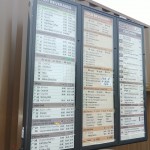When going about setting up your drive-thru lane you may find yourself in one of three scenarios:
- New build/design which provides you the greatest deal of latitude in regards to setting up your lane.
- Adding a drive-thru to an existing location through a remodel which limits your ability to do whatever you’d like
- You’ve inherited a pre-existing drive-thru location that often defines where you’re going to place your drive-thru from the outset.
 In the circumstances of #3, a lot of the guesswork is taken out. Unless it has been decades since it’s the last inhabitant, the conduit should be in decent condition, the concrete pads should indicate drive-thru and speaker post-placement and it usually becomes a matter of drilling in some new red heads to match the bolt pattern of the drive-thru on its way. On the flip side, you may have more to consider for #1 and #2 and quite often space and budget are the driving forces.
In the circumstances of #3, a lot of the guesswork is taken out. Unless it has been decades since it’s the last inhabitant, the conduit should be in decent condition, the concrete pads should indicate drive-thru and speaker post-placement and it usually becomes a matter of drilling in some new red heads to match the bolt pattern of the drive-thru on its way. On the flip side, you may have more to consider for #1 and #2 and quite often space and budget are the driving forces.
For the purposes of this post, we’ll look at a typical single-lane setup where you have the drive-thru window, drive-thru menu board and the speaker post with its components outside (speaker/mic) and the means for employees to talk to customers (headsets). The main focus will be on the menu board itself and which route you should go, freestanding or wall-mounted. The driving force behind this should be how many cars you can stack from the window to the menu board. The average car length is just over 15′. With that in mind, the minimum ideal scenario would see one car at the window, two stacked behind that and the fourth and the drive-thru menu board. Of course, there is a myriad of other factors (i.e. your parking lot) that simply may not allow you to do this.
Freestanding:
The Benefits- Freestanding a drive-thru allows for the greatest visibility for all of those in the car. The board would be recessed back off the curb with the speaker post closer to the car. This allows those on the passenger side to more readily see the menu. Usually, freestanding is necessary to provide more distance from the window to where the customer orders thus allowing for more room to stack cars.
The Drawbacks- The only negative here is the cost. Freestanding a board means that you have to get conduit ran outside, concrete pads to be poured with anchors, potentially islands to be made, etc. This can take a small number of trades to accomplish which ratchets up the installation cost.
Wall Mounted:
The Benefits- Unlike the drawbacks for the freestanding, wall mounting a board brings costs down for a couple of reasons. The board itself is cheaper due to the fact that there is simply less material. The boards are thinner because they don’t have to be erected in the open and rated to withstand winds up to 150 mph. Installation, no need for conduits or concrete pads, simply a punch-out from inside for speaker and mic wire and some screws through the can of the sign to secure it in place.
The Drawbacks- Similar to a freestanding board with onboard speaker and mic a wall-mounted board is OK for the driver and to a lesser degree the driver side passenger(s) in the back. You pull up right in front of the sign which makes it next to impossible for passenger side folks to see the board without activating their best yoga position. In addition to this, most wall-mounted boards limit the stacked cars to less than what would be quintessential.
Considering what has been outlined here you should now be more informed on which route would A- best serve your business and B- make the most financial sense. Adding a drive-thru to your location is something that should be considered a long term investment to your business and should be set up correctly the first time. Going back and having to jackhammer concrete to run new conduit and dig to put new footers down are things you should look to avoid in the future.
Comments or Questions? Reach out to us at sales@origindisplays.com or 888-235-2578